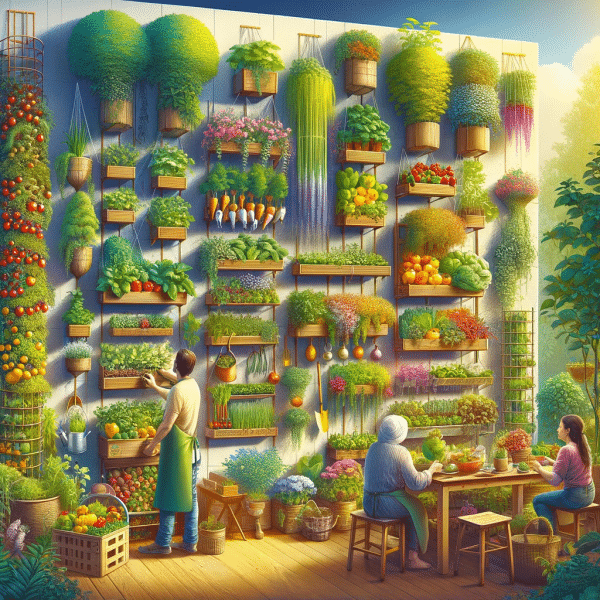
Vertical Gardening 101: A Guide to Growing Your Own Food Year-Round
Welcome to the world of vertical gardening, where the sky's the limit when it comes to growing your own food. Imagine having fresh, homegrown produce right at your fingertips, no matter the season. It's not a dream; it's the beauty of vertical gardening.
In this guide, we'll take you on a journey through the lush and vibrant world of vertical gardening, showing you how to turn your space into a year-round food haven. Let's start by understanding what vertical gardening is all about and why it's a game-changer for those who crave self-sufficiency and a low carbon footprint.
Vertical gardening is like a green revolution in the world of horticulture. It's a technique that takes the traditional idea of gardening and turns it on its head, quite literally. Instead of planting in expansive horizontal plots, you'll be growing vertically, stacking plants in layers. It's a bit like nature's skyscrapers, with each level housing a different variety of plants.
Now, why is this so exciting? Well, first and foremost, it's incredibly space-efficient. Whether you have a sprawling backyard or a compact balcony, you can create a thriving vertical garden. This means you can grow your own food even if you thought you didn't have the room for it.
But that's not all; vertical gardening brings a host of other benefits to the table. It's like having a toolbox of solutions for modern-day challenges. Concerned about your carbon footprint? Vertical gardening can reduce it. Worried about pesticide residues in your food? Vertical gardens provide a safer, more controlled environment for your plants. Plus, they're a ticket to year-round fresh produce, no matter where you live.
So, if you're ready to embark on a journey of greenery and self-sufficiency, keep reading. In the next parts of this guide, we'll delve deeper into the specifics of vertical gardening, from selecting the right plants to mastering the art of year-round cultivation. Get ready to make your garden reach new heights!
Selecting the Right Plants for Year-Round Cultivation
Now that you've had a taste of what vertical gardening is all about, let's dive deeper into the specifics. One of the key ingredients for a thriving vertical garden is choosing the right plants. After all, your goal is year-round cultivation, and that means understanding what will flourish in your vertical oasis.
Think of it like assembling a dream team. In this case, your dream team is a collection of plants that can thrive in a vertical environment. When selecting your lineup, consider factors like the climate in your area, the amount of sunlight your vertical garden receives, and your personal preferences.
Here's where it gets exciting. Vertical gardening isn't just about traditional crops like tomatoes and cucumbers (although they can certainly be part of the mix). It's an opportunity to get creative with your plant choices. You can grow herbs, strawberries, leafy greens, and even dwarf fruit trees. The possibilities are nearly endless.
Now, let's talk about the magic of herbs. They're like the flavor wizards of your garden, adding zest and aroma to your dishes. Basil, rosemary, and mint are some popular choices that do exceptionally well in vertical gardens. Just imagine plucking fresh basil leaves for your homemade pizza anytime you want.
If you're a fan of fresh salads, leafy greens like lettuce, spinach, and arugula are fantastic options. They're quick growers, meaning you can enjoy a continuous supply of salad greens year-round. It's like having your personal salad bar right outside your door.
For those who dream of picking their own berries, consider strawberries. They're compact, delightful, and perfect for vertical gardening. Picture yourself harvesting juicy red strawberries in the middle of winter - that's the magic of vertical gardening.
And if you've got a sweet spot for fruit trees, don't worry; you can still make it work in a vertical garden. Dwarf fruit tree varieties are ideal for limited space and can provide you with homegrown apples, pears, or cherries.
So, as you plan your vertical garden, think about the flavors and aromas that bring joy to your life. What would you love to have at your fingertips year-round?
Mastering Light and Temperature Control
Welcome back to the world of vertical gardening, where each layer of greenery holds the promise of fresh, homegrown goodness. Now that you've picked the stars of your garden, it's time to understand the backstage secrets to success: light and temperature control.
Imagine your plants as performers in a play. They need the right stage setup, and that means getting the lighting just right. In the world of vertical gardening, sunlight is the spotlight, and your plants are the stars. Most plants require at least 6 hours of direct sunlight daily to thrive. But what if your vertical garden doesn't get that much sun?
That's where the magic of adjustable lighting comes in. You can provide supplementary lighting to ensure your plants get the spotlight they deserve. LED grow lights are like the stage lights for your garden. They come in various spectrums to mimic natural sunlight, so your plants can photosynthesize to their heart's content, no matter the weather outside.
Temperature control is another critical aspect of year-round gardening. Different plants have different preferences when it comes to temperature. Some thrive in the heat, while others prefer cooler conditions. It's like accommodating a diverse cast in your garden theater.
If you're growing herbs like basil or rosemary, they enjoy warmer temperatures. On the other hand, cool-season crops like lettuce and spinach prefer a cooler environment. Vertical gardens allow you to control the microclimate, making it easier to cater to your plants' temperature needs.
So, how do you manage temperature? One way is by choosing the right location for your vertical garden. If you live in a hot climate, consider placing your garden in a spot that gets some shade during the hottest part of the day. In colder regions, you can use reflective materials to capture and retain heat, creating a cozy environment for your plants.
By mastering light and temperature control, you're ensuring that your vertical garden can perform its best year-round. Just like a well-directed play, with the right lighting and temperature, your garden will flourish, and you'll reap the rewards of your efforts.
Now that you're armed with the knowledge of plant selection and environmental control, you're well on your way to becoming a vertical gardening pro. In the next part, we'll discuss essential techniques for watering, fertilizing, and keeping pests at bay. Get ready to nurture your garden like a seasoned gardener!
